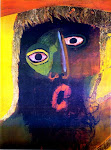Apr 24th 2008
From The Economist print edition
Vietnam's quest for role models
A BELL chimes at noon in the pastel-coloured Cao Dai Grand Temple, about 100km (63 miles) from Ho Chi Minh City, and hundreds of worshippers in coloured robes and a variety of headgear file in. They sit cross-legged among pink columns with carvings of gaudy green-and-white dragons. All around them is their religion's symbol, the all-seeing eye. The place looks like a cross between a Chinese temple, a mosque and a Catholic church, with a touch of the Wizard of Oz's Emerald City.

Cao Dai, Vietnam's syncretistic home-grown religion, mixes Buddhism, Taoism, Christianity, Islam and other religions, teaching that all faiths are manifestations of “one same truth”. The religion was founded in 1926 by Ngo Van Chieu, a government official. By the 1940s it had become a powerful force, maintaining its own private army. It supported the Japanese occupation and at times the pro-American South Vietnamese regime, so after 1975 it was repressed by the Communists. Now, as the government eases up on religion, Cao Dai is back in favour, albeit strictly controlled. In February members of the government committee for religious affairs joined 200,000 Caodaists for a grand ritual at the temple.
Cao Dai's sunny, ecumenical message chimes well with Vietnam's foreign policy of seeking “friends everywhere”. More broadly, the faith reflects a quintessentially Vietnamese trait: casting around for role models, then trying to meld the best aspects of several of them into something uniquely suited to Vietnam.
That may come naturally to a country that has been occupied and influenced by so many foreign powers. The Vietnamese legal system is based mainly on Napoleonic principles but with bits adapted from the Chinese and Soviet models. When Vietnam was under the Soviet Union's wing during the cold war, it copied its collectivist economic model, with disastrous results. Next, it emulated Deng Xiaoping's market socialism. More recently it has grafted on elements of the World Bank's and UN agencies' anti-poverty growth models and, increasingly, the rudiments of a welfare state along European lines.
China lite
It is tempting to view Vietnam as a mini-China, since both countries are run by ardently capitalist communists, but there are differences. A foreign diplomat in Hanoi who used to serve in Beijing says that “everything here is more moderate than in China.” Vietnam is a bit less harsh with dissidents than China, and its capitalism too is less red in tooth and claw. Its health and education services have adapted more successfully to the transition to a market economy. Its press is strictly controlled, as in China, but the growing numbers of internet surfers have free access to most foreign news websites: there is no Vietnamese equivalent of the Great Firewall of China.
Whereas China is led from the top down and one man is clearly the paramount leader—Hu Jintao, who is both the head of the Communist Party and the state president—Vietnam has a consensual leadership. Its triumvirate of president, party boss and prime minister must reach accommodations with an increasingly independent national assembly and a host of other forces, and avoid upsetting the many surviving heroes of Vietnam's independence wars. China's leadership can ram through public-works projects regardless of the consequences. In contrast, the decision-making process in Vietnam can seem painfully slow—but also more equitable.
China enforced a one-child policy harshly; Vietnam had a two-child policy, pursued half-heartedly. Whereas China is already greying, Vietnam's post-war baby-boomers are now coming into their prime, and rapid economic growth has been providing jobs for them all. HSBC's chief in Vietnam, Tom Tobin, notes that in a decade or two, when much of the rest of the world will be ageing rapidly, Vietnam's boomers will still be at the most productive phase of their careers.
China remains the most obvious role model for combining market reforms with communist ideology, though most Vietnamese would be loth to admit to copying their ancient foe. But Vietnam's ruling party also looks to rich Singapore, nominally a free-market democracy but in practice a one-party state whose government still controls the commanding heights of the economy. For example, Vietnam has created a carbon copy of Temasek, a Singaporean investment agency, to retain its stakes in part-privatised firms.
Clearly Vietnam is too big and too decentralised to be able to copy tiny Singapore, but its Communist Party hopes to pull off the same trick as Singapore's People's Action Party (PAP), persuading the voters to accept its continued rule as the price of prosperity. Like the PAP, the Vietnamese Communists seek to recruit academic high-flyers and budding thinkers to their inner circle at an early stage.
Noting that higher education and scientific innovation were the keys to riches for Japan, South Korea and Taiwan, Vietnam is wooing foreign high-tech firms and inviting rich countries to set up universities and training facilities on its soil. An Australian university, the Royal Melbourne Institute of Technology, has already opened state-of-the-art campuses in Ho Chi Minh City and Hanoi. A German university and several South Korean technical colleges are planned. Meanwhile families from the prime minister's downwards are sending their youngsters to study abroad.
So what shape will Vietnam's syncretistic economy take? As the country seeks to build strong national companies, it is as yet unsure whether to model them on Japanese keiretsu, Korean chaebol or Anglo-Saxon companies that focus on their core business. Maybe it will manage to take the best bits of each model. But Tony Salzman, an American businessman in Vietnam, worries about the danger of “the collars not matching the cuffs”.

Aucun commentaire:
Enregistrer un commentaire